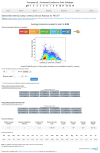Proteome-pI: proteome isoelectric point database
- PMID: 27789699
- PMCID: PMC5210655
- DOI: 10.1093/nar/gkw978
Proteome-pI: proteome isoelectric point database
Abstract
Proteome-pI is an online database containing information about predicted isoelectric points for 5029 proteomes calculated using 18 methods. The isoelectric point, the pH at which a particular molecule carries no net electrical charge, is an important parameter for many analytical biochemistry and proteomics techniques, especially for 2D gel electrophoresis (2D-PAGE), capillary isoelectric focusing, liquid chromatography-mass spectrometry and X-ray protein crystallography. The database, available at http://isoelectricpointdb.org allows the retrieval of virtual 2D-PAGE plots and the development of customised fractions of proteome based on isoelectric point and molecular weight. Moreover, Proteome-pI facilitates statistical comparisons of the various prediction methods as well as biological investigation of protein isoelectric point space in all kingdoms of life. For instance, using Proteome-pI data, it is clear that Eukaryotes, which evolved tight control of homeostasis, encode proteins with pI values near the cell pH. In contrast, Archaea living frequently in extreme environments can possess proteins with a wide range of isoelectric points. The database includes various statistics and tools for interactive browsing, searching and sorting. Apart from data for individual proteomes, datasets corresponding to major protein databases such as UniProtKB/TrEMBL and the NCBI non-redundant (nr) database have also been precalculated and made available in CSV format.
© The Author(s) 2016. Published by Oxford University Press on behalf of Nucleic Acids Research.
Figures


References
-
- Po H.N., Senozan N.M. The Henderson-Hasselbalch equation: its history and limitations. J. Chem. Educ. 2001;78:1499.
-
- Hoogland C., Mostaguir K., Sanchez J.C., Hochstrasser D.F., Appel R.D. SWISS‐2DPAGE, ten years later. Proteomics. 2004;4:2352–2356. - PubMed
-
- Bunkute E., Cummins C., Crofts F.J., Bunce G., Nabney I.T., Flower D.R. PIP-DB: the protein isoelectric point database. Bioinformatics. 2015;31:295–296. - PubMed
MeSH terms
Substances
LinkOut - more resources
Full Text Sources
Other Literature Sources
Molecular Biology Databases
Research Materials
Miscellaneous

